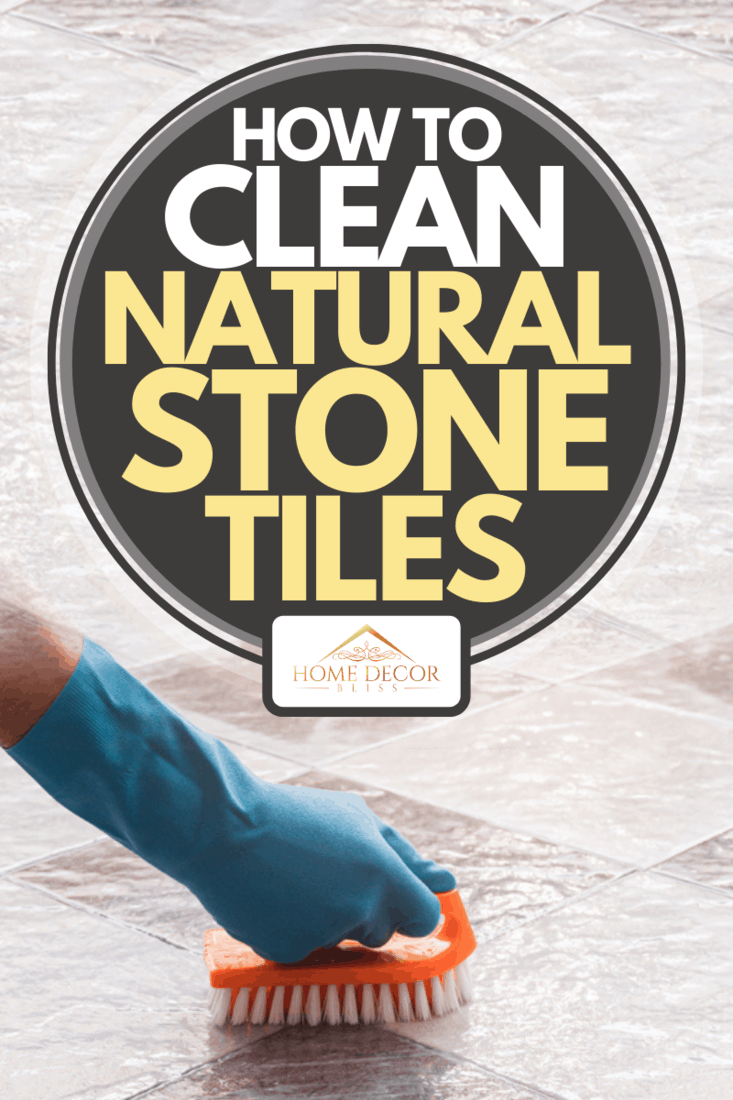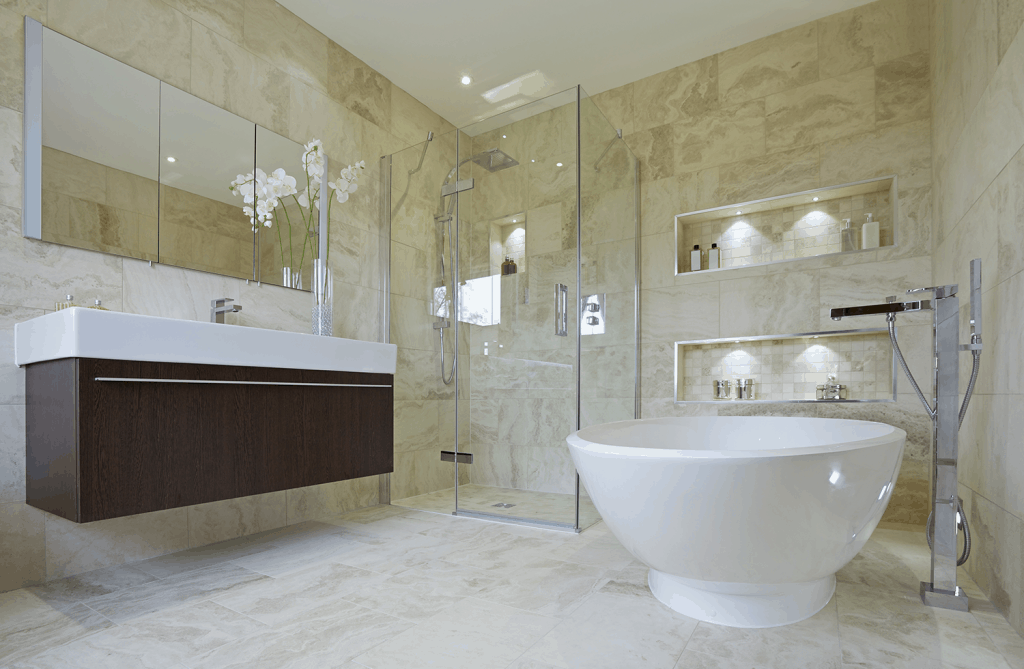Natural stone tile floors are beautiful; however, proper cleaning is required to maintain durability and elegance. We consulted scientific and governmental data and researched installer, cleaner, and distributor guidelines to determine the best and safest ways to preserve and clean stone tile floors.
A basic set of guidelines will help you easily clean and maintain your beautiful natural stone floors.
- Gather Personal Protective Equipment (PPE).
- Select stone-safe grout and stone cleaning products.
- Remove loose dirt and dust particles.
- Clean grout with stone-safe cleaner.
- Clean tile with stone-safe cleaner.
- Allow the floor to dry completely.
- Add finishing touches.
Natural stone floors are best kept beautiful with a regular cleaning routine. Not only will this facilitate floor maintenance, but regular debris removal will protect the tiles from scratches made by dirt or stains made by spills allowed to soak into the stone. Join us for a walk through some handy stone tile flooring cleaning steps.

What is natural stone tile?
Natural stone tiles are made from large pieces of rock that have been removed from the earth, sliced into slabs, often polished, and then cut into smaller tile-sized pieces. Natural stone does not refer to synthetic materials manufactured to resemble stone. The Natural Stone Council describes granite, limestone, marble, quartzite, onyx, sandstone, slate, and travertine as genuine stone harvested from the earth and fabricated without altering the natural fabric.

We may include affiliate links and curated AI content to highlight top design styles.
While certain elements will hold true when caring for your stone floor, you will want to verify you know your floor type to ensure you are providing the best care related to the porousness, coloring, and other characteristics of your floor. The more absorbent the floor, the more likely it will be to stain and crack. Granite is the least porous; sandstone is the most porous. Finishing techniques may alter the absorbency rate. Contact a stone flooring expert if you are unsure about your natural stone floor’s characteristics.
1. Gather Personal Protective Equipment (PPE).
PPE (Personal Protective Equipment) consists of any equipment you need to protect your skin, breathing, and eyes from chemicals, dust, burns, cuts, or other hazards you may encounter when undertaking a task. You may not need all of these items but choose what is needed based on your health conditions and the cleaning solution you utilize. Wear the material formulation and level of PPE related to your health and environmental conditions. Consider any allergies (latex gloves) when selecting PPE.
Check out Tusko Rubber Latex-free Gloves at Amazon.
Check out 3M Chemical Goggle at Amazon.
Key pieces of PPE, respirators keep you from inhaling hazardous substances, per OSHA (Occupational Safety and Health Administration). Consult your medical professional concerning respirator use since health conditions, such as asthma or high blood pressure, may trigger health issues during respirator use. Full-face and half-face options are available.
Check out the 3M Half Facepiece Respirator at Amazon.
Remember to purchase the filter specific to your job.
Check out the 3M Respirator Filter at Amazon.
2. Choose a stone-safe cleaning product.
When cleaning your natural stone tiles, use pH-neutral cleaners. Put simply, pH represents the amount of Hydrogen ions (H+) a solution contains. The pH scale range is 0 to 14. Acids fall below 7, alkaline solutions have values above 7, and pH7 is neutral. The best cleaners for your natural stone floors will say pH7, neutral, or residue-free. Acid or alkaline cleaners may cause damage to your natural stone floors and could cause permanent etching.
Check out Black Diamond Stoneworks pH Neutral Cleaner at Amazon.
Can you use vinegar on stone tile?
While many natural cleaners offer a great option for cleaning, vinegar is an acid and may cause permanent damage to natural stone tiles. Some other natural stone damaging acids are alcohol and lemon. Ammonia and bleach are alkaline solutions and may also lead to irreversible damage.
3. Remove loose dirt and dust particles.
Remove loose dirt and dust from your floor. Choose the proper cleaning product for the stone you have. If you vacuum, use the bare floor setting so the beater bar does not damage your floor. You will also want to verify all attachments are working properly.
Check out the Shark Cordless Vacuum at Amazon.
If you have uneven floor surfaces, a broom may provide a good option for removing debris from the varied surfaces. Smooth floors may benefit from a soft cloth cleaner rather than a broom or vacuum.
Check out the Swiffer Sweeper Dry + Wet Mopper at Amazon.
4. Clean the grout between the natural stone tiles
Go ahead and scrub the grout with a stone-safe cleaner and non-abrasive brush that will not damage the natural stone tiles. Alternatively, spray grout with a stone-safe cleaner and let it set so the cleaner may be removed when the rest of the floor is cleaned. Most stains are difficult to remove from grout. Seal grout often with stone-safe sealant and prevent stains as much as possible.
Check out Granite Gold Grout Cleaner and Scrub Brush for Natural Stone Surfaces at Amazon.
5. Clean tile with stone-safe cleaner.
A spin mop and bucket combo will minimize the water you are putting on your stone floor and will keep you from having to bend as you clean the floor.
An all-in-one vacuum and mop multi-surface machine will facilitate regular cleaning and speedier drying. For most machines the cleaning solution is kept in a separate tank from the dirty water that is removed from the floor, providing a cleaner surface.
Check out the Bissell Crosswave All-in-One Wet-Dry Vacuum Cleaner and Mop at Amazon.
How do you get stains out of natural stone?
Remove spills as quickly as possible from your natural stone tiles. Blot with a paper towel or soft cloth. If the liquid is oily, make a paste with baking soda and water and leave it on the area for 24 hours. Wash the area with a neutral cleaner and damp cloth. Rinse then dry with a cloth. Allow to fully dry.
Check out Arkwright Microfiber Cleaning Cloths at Amazon.
For a stain that you are unable to easily remove, consult a professional. Improper stain removal techniques may forever ruin a section of your flooring. While most stain issues may be resolved by common treatments, and the beauty of some natural stone varieties is the color irregularity, some stain overtreatments cannot be undone and will cause physical stone damage or unattractive visible.
How do you remove scuffs?
Rub a tennis ball on scuffs to gently remove them from your stone floor surfaces. For scratches on porous stone floors (think limestone or sandstone), try rubbing a bit of linseed, olive, or mineral oil into the scratch with a soft cloth to help fade the scratch.
6. Allow the floor to dry completely.
After you have finished cleaning your natural stone tiles, let the floor dry completely. Floors will dull if dirt meets the wet cleaning solution, and mildew will grow if rugs are placed on wet floors.
7. Add finishing touches.
Now that your natural stone tiles are clean and dry, you will want to add any needed finishing touches to protect your floors and make them sparkle.
How do you make natural stone shine?
If floors become dull and need a little extra help, some specialty techniques exist. While you can do these yourself, call in the experts if you have any doubt.
A floor machine provides multiple options for helping shine natural stone floors. Consult the floor machine guidelines and floor type specifications to see which method and materials work for your natural stone floor tiles. Polishing uses a buffing pad with a polishing powder to add a reflective gloss. Honing uses specialty floor pads with a coating of microscopic diamonds and water. Crystallization is used to polish calcium-based floors.
Check out the Oreck Commercial Orbiter Floor Machine at Amazon.
Do natural stone tiles need sealants?
Natural stone tiles have microscopic pores that soak up liquids. Periodically, you will need to seal your tiles and grout to provide the best surface protection. Verify sealant guidelines and utilize one intended for your tile and grout installation.
Check out Miracle Sealants Porous Plus Penetrating Sealer at Amazon.
Summary
Keeping natural stone tiles beautiful is an easy process if viewed as part of a regular routine. Blot spills as soon as they occur so they do have an opportunity to seep into the stone becoming a dark stain. Use an all-in-one vacuum and mop machine or use a broom and mop regularly to help ensure dirt does not scratch or dull your stone floor.
You may also enjoy these posts.
Is Stone Veneer Worth It? Stone Interior Walls Pros And Cons
















